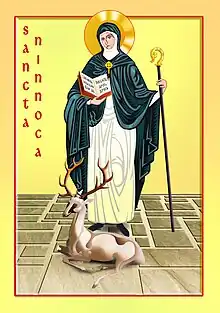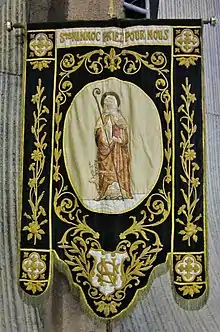Saint Ninnoc | |
|---|---|
 | |
| Virgin, Abbess | |
| Born | c. 414 Wales |
| Died | 4 June 467 (aged 52–53) Lannenec Monastery, Ploemeur, France |
| Venerated in | Catholic Church |
| Canonized | Pre-Congregation |
| Feast | 4 June |
| Attributes | Religious habit Crosier Book Deer |
| Patronage | Agriculture Forestry Women |
Saint Ninnoc or Ninnog of Breton (c. 414 – c. 4 June 467[note 1]), also known as Nenooc, Nennoca, Nennocha, Ninnoc, Ninnocha, and Gwengustle, was an early medieval abbess who was reputedly born in Wales and died in Brittany. The text of Vita Sanctae Ninnocae (The Life of Saint Ninnoc) is preserved in the Cartulary of Quimperlé, and it provides knowledge of her life and works.
Biography
According to the Vita Sanctae Ninnocae, which was written c. 1130 and is preserved in the Cartulaire de l'abbaye de Sainte-Croix de Quimperlé (fr), St Ninnoc was reputedly born in Wales and her father was King Brychan[3] and her mother Meneduc.[4] They had fourteen sons, all of whom left their parents' home after they were inspired to become missionaries.[4] Brychan and Meneduc prayed, promising a tenth of all their possessions to the church if they were granted a child who could inherit.[4] This child was Ninnoc, who was sent to live with her godparents soon after her birth.[5]
When Ninnoc was fifteen, a Scottish prince asked to marry her. Ninnoc, who had recently met and heard the preaching of Germanus, a disciple of St Patrick, instead wanted to devote herself to God,[2] and after Germanus's intervention, her father granted her wish and sent her to Brittany with a "ship, money and attendants".[4]
In Brittany she was welcomed by King Gueric of the Bretons and was granted a settlement on the southern coast of Brittany, where she founded a religious house and became its abbess.[4][6] The house was a double monastery for men and women.[1] The establishment became known as Lannennoc after her: the suffix '-nennoc' is said to derive from Ninnoc.[6] She reportedly taught new agricultural techniques to the local Breton communities, as well as encouraging tree planting so they could better support themselves.[6] Abused women found shelter at Lanennoc and Ninnoc became known as a protector of women.[6]
Ninnoc lived at her monastery for approximately thirty-eight years, until her death.[1] The book Les petits Bollandistes vies des saints de l'Ancien et du Nouveau gives Ninnoc's year of death as 467,[7] reportedly after a short illness.[8] This date, combined with her feast day of 4 June, has become her reported date of death.[9] However, since there is doubt over the veracity of the Vitae, these dates are not certain.[10]
It has been proposed that Ninnoc's double-house at Lannénec near Ploemeur was destroyed by Vikings in the ninth or tenth century.[11] The church was re-built in the twelfth century, but no trace of the earlier building remains.[11]
Veneration

Feast days
The feast of St Ninnoc, Virgin and Abbess, is celebrated on 4 June in Brittany.[1] In Ireland, a Saint Ninne (of whom there is no record) is remembered on 3 June, and it has been suggested by the historian Sabine Baring-Gould that she is connected to Ninnoc's cult.[2]
Iconography
Artistic representations of her often show a stag at her feet, which could represent the vulnerable women who came under her guardianship.[6] However, this may also refer to a story from her Vitae in which a stag, being hunted by King Gueric, came into the church for shelter and laid at Ninnoc's feet— on seeing this Gueric stayed at the church for seven days praying, and afterwards granted the settlement more land, 300 horses and more cattle.[4] There are accounts of the veneration of St Ninnoc in the seventh and eighth centuries in England.[4]
Canonization
Miracles were attributed to Ninnoc during her lifetime and, according to her Vitae, she was canonised a few years after her death.[6]
Historiography
St Ninnoc is not mentioned in any contemporary sources and her Vitae was recorded in the twelfth century, almost seven hundred years after she lived, and existing scholarship dates to the nineteenth and early twentieth centuries.[1][2][4] In Lives of the British Saints, Baring-Gould points out several inconsistencies between her Vitae and other documentary evidence.[2] Baring-Gould also refutes the idea that it was St Germanus of Auxerre who preached to Ninnoc, as repeated by Dunbar in A Dictionary of Saintly Women.[2] Confusion between a Germanus and St Germanus is repeated in some modern sources.[12]
Whilst Wales is generally accepted as her place of birth, Scotland or Cumbria have both been suggested.[3] Some sources also place Ninnoc's life in the eighth century.[13] Others consider her a Cornish saint.[14]
Vita Sanctae Ninnocae
In common with other Vitae, the Life of St Ninnoc is likely to be an exaggerated account based on truth.[15] The production of the Vitae in the twelfth century was also a political act, which aimed to legitimise the holdings of the Sainte-Croix Abbey—in this case to assert its rights over the land around Lannennec.[16] This use of her Vitae as a tool for legitimacy is compounded by the fact it is not placed at the start of the cartulary but is in the local property sections.[17] The cartulary does not claim her relics.[17]
Notes
References
- 1 2 3 4 5 Stanton, Richard (1892). A menology of England and Wales, or, Brief memorials of the ancient British and English saints arranged according to the calendar, together with the martyrs of the 16th and 17th centuries. University of California Libraries. London ; New York : Bunrs & Oates. p. 253.
- 1 2 3 4 5 6 Baring-Gould, S. (Sabine) (1907–1911). The lives of the British Saints: the Saints of Wales and Cornwall and such Irish Saints as have dedications i n Britain. PIMS - University of Toronto. London : For the honourable Society of Cymmrodorion by C.J. Clark. pp. 17–20.
- 1 2 Edwards, William (1890). "The Settlement of Brittany". Y Cymmrodor. XI.
- 1 2 3 4 5 6 7 8 Dunbar, Agnes Baillie Cunninghame (1904). A Dictionary Of Saintly Women, Volume 2. London : Bell. p. 106.
- ↑ Parkes, Peter (2006). "Celtic Fosterage: Adoptive Kinship and Clientage in Northwest Europe". Comparative Studies in Society and History. 48 (2): 359–395. doi:10.1017/S0010417506000144. ISSN 0010-4175. JSTOR 3879355. S2CID 146501187.
- 1 2 3 4 5 6 "Ninnoc (fl. 6th c.) | Encyclopedia.com". www.encyclopedia.com. Retrieved 29 October 2020.
- ↑ Les petits Bollandistes vies des saints de l'Ancien et du Nouveau Testament ...: du 19 mai au 13 juin (in French). Louis Guérin. 1872. p. 441.
- ↑ Le Grand, Albert (15-1640 ?) Auteur du texte (1901). Les vies des saints de la Bretagne Armorique : ensemble un ample catalogue chronologique et historique des evesques d'icelle... et le catalogue de la pluspart des abbés, blazons de leurs armes et autres curieuses recherches... (5e éd.) / par fr. Albert Le Grand,... ; reveu et corrigé par messire Guy Autret, chevalier, seigneur de Missirien ; augmenté de plusieurs vies des saints de Bretagne, par le mesme, par missire Julien Nicole,... et autres. p. 274.
{{cite book}}: CS1 maint: numeric names: authors list (link) - ↑ "Ploemeur : Histoire, Patrimoine, Noblesse (commune chef lieu de canton)". www.infobretagne.com. Retrieved 10 November 2020.
- ↑ "A Welsh Classical Dictionary | The National Library of Wales | St Nennocha". www.library.wales. Retrieved 10 November 2020.
- 1 2 Bertrand, Roger; Lucas, M. (1975). "Un village côtier du XIIe siècle en Bretagne : Pen-er-Malo en Guidel (Morbihan)". Archéologie médiévale. 5 (1): 73–101. doi:10.3406/arcme.1975.1282.
- ↑ "Sainte Ninnoc". nominis.cef.fr. Retrieved 29 October 2020.
- ↑ Molinier, Auguste (1901). "403. Ninnoca (S.), abbesse". Collections numériques de la Sorbonne. 1 (1): 133.
- ↑ Monod, Gabriel; Thévenin, Marcel; Roy, Jules; Bémont, Charles; Reuss, Rodolphe; Lot, Ferdinand (1909). "VI. Histoire". Annuaires de l'École pratique des hautes études. 42 (1): 49–56.
- ↑ Bruel, A. (1897). "Review of Cartulaire de l'abbaye de Sainte-Croix de Quimperlé". Bibliothèque de l'École des chartes. 58: 460–462. ISSN 0373-6237. JSTOR 43003852.
- ↑ Tanguy, Bernard (1989). "De la Vie de saint Cadoc à celle de saint Gurtiern". Études celtiques. 26 (1): 159–185. doi:10.3406/ecelt.1989.1909.
- 1 2 Jankulak, Karen. "Breton Vitae and Political Need in the Cartulary of Sainte-Croix de Quimperlé." Literature and Politics in the Celtic World. Papers from the Third Australian Conference of Celtic Studies, University of Sydney. 1998.